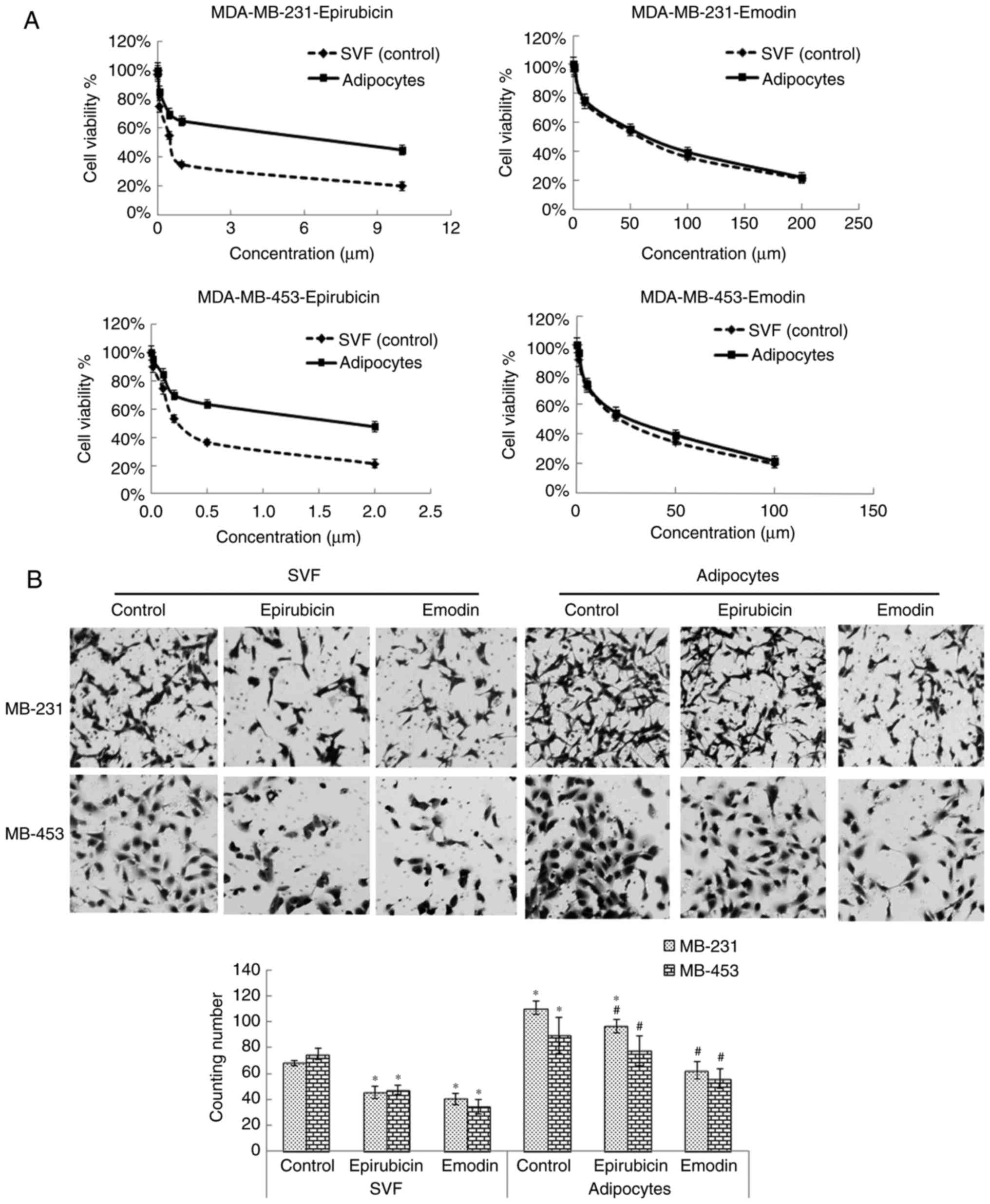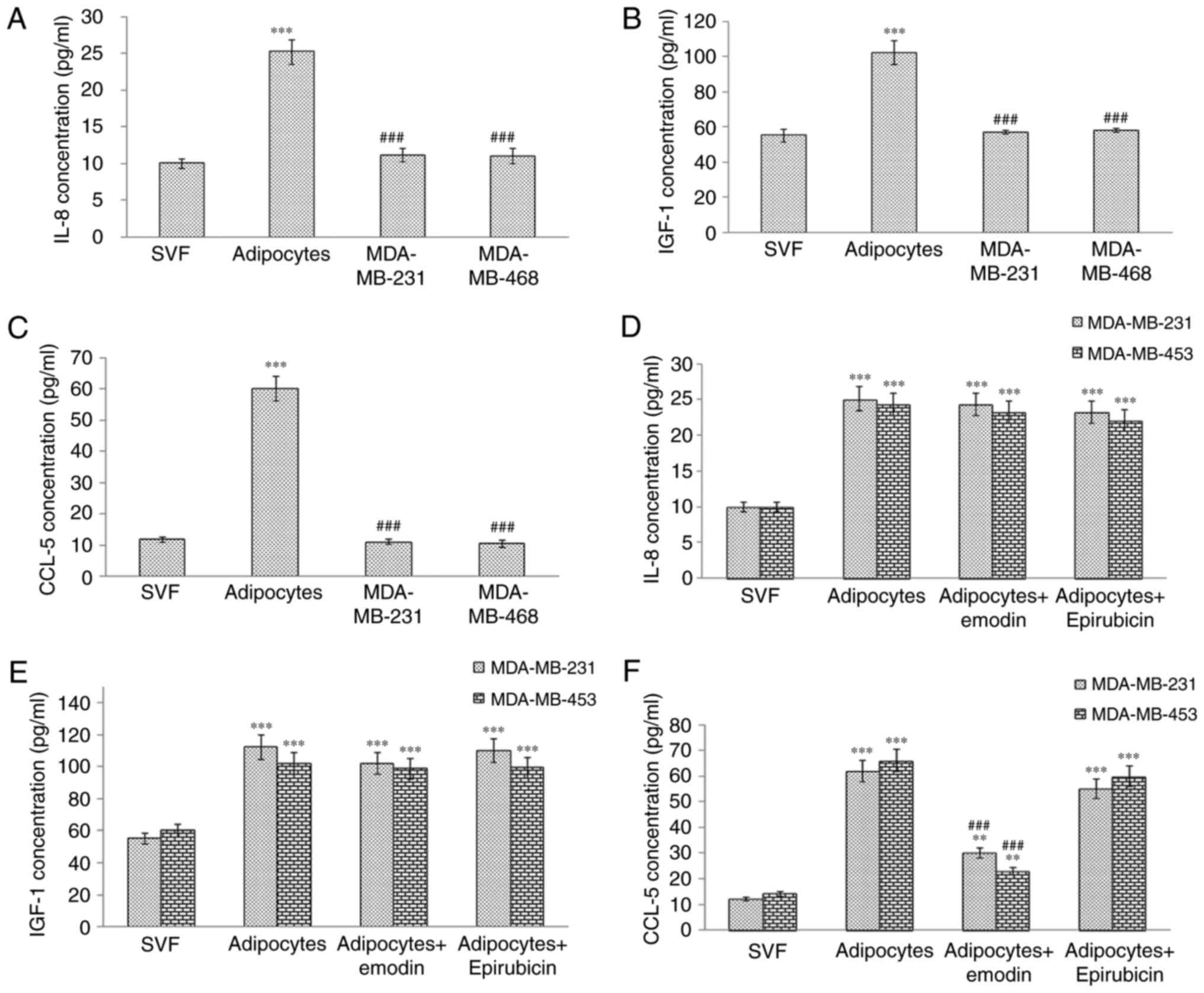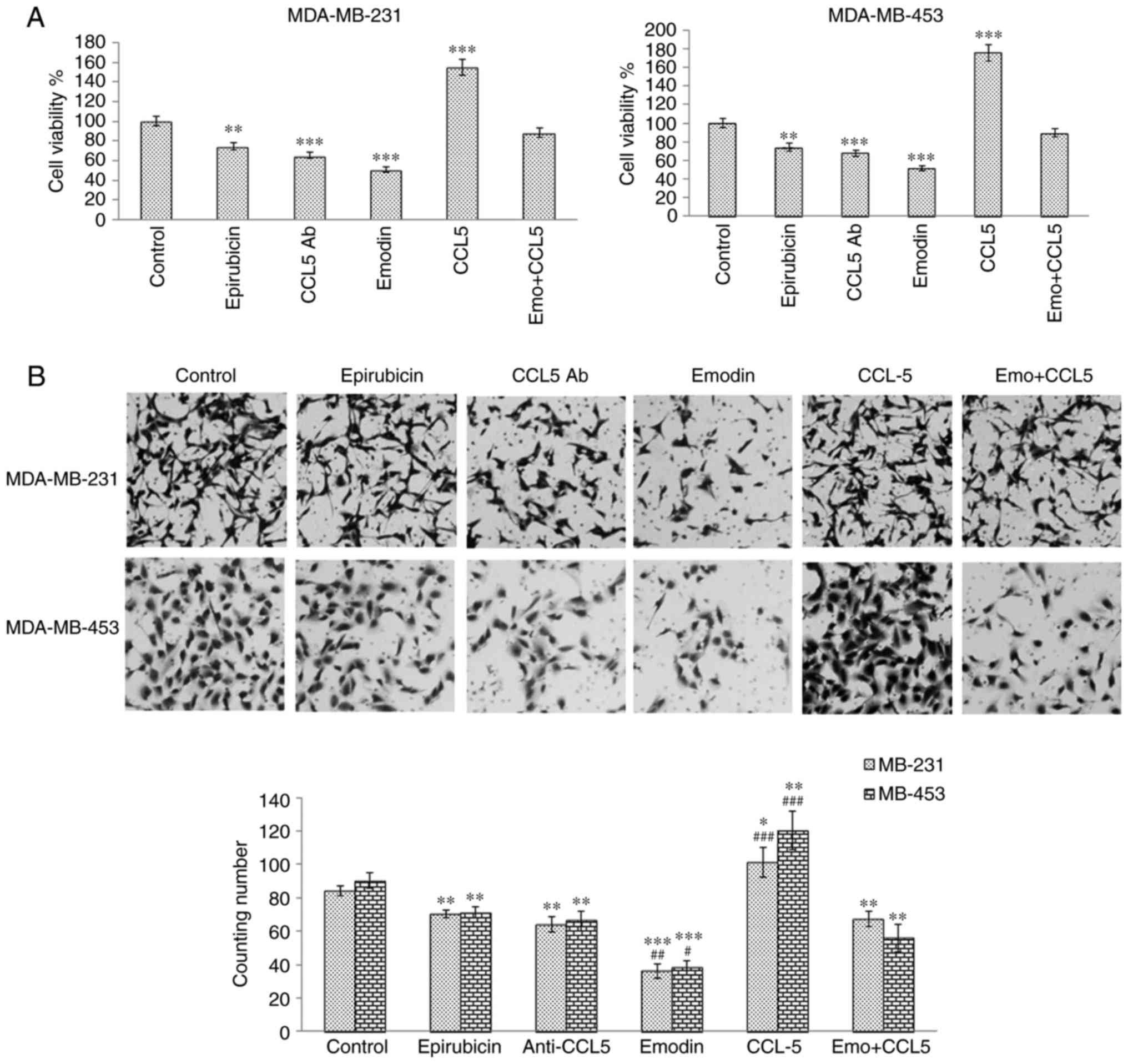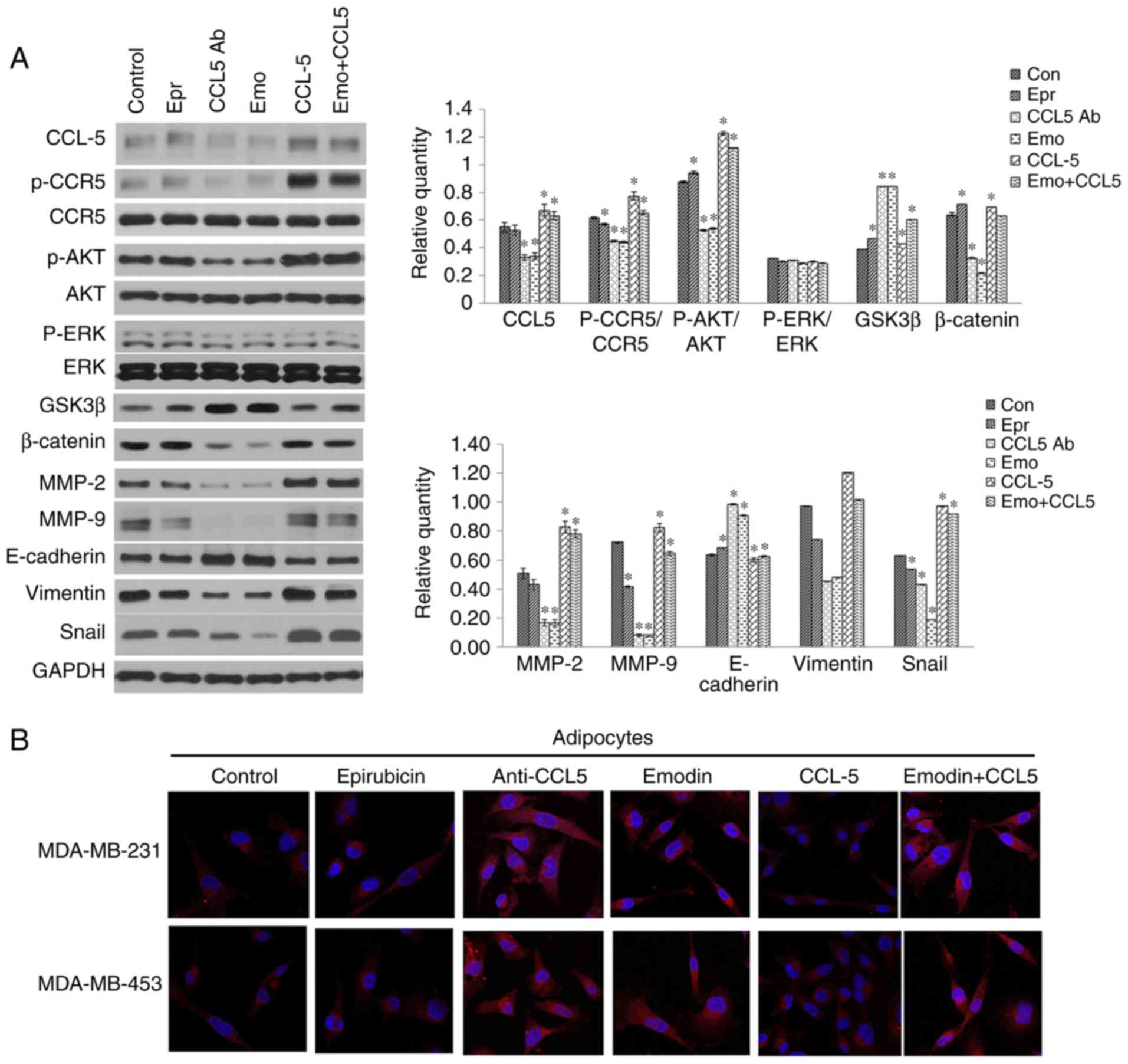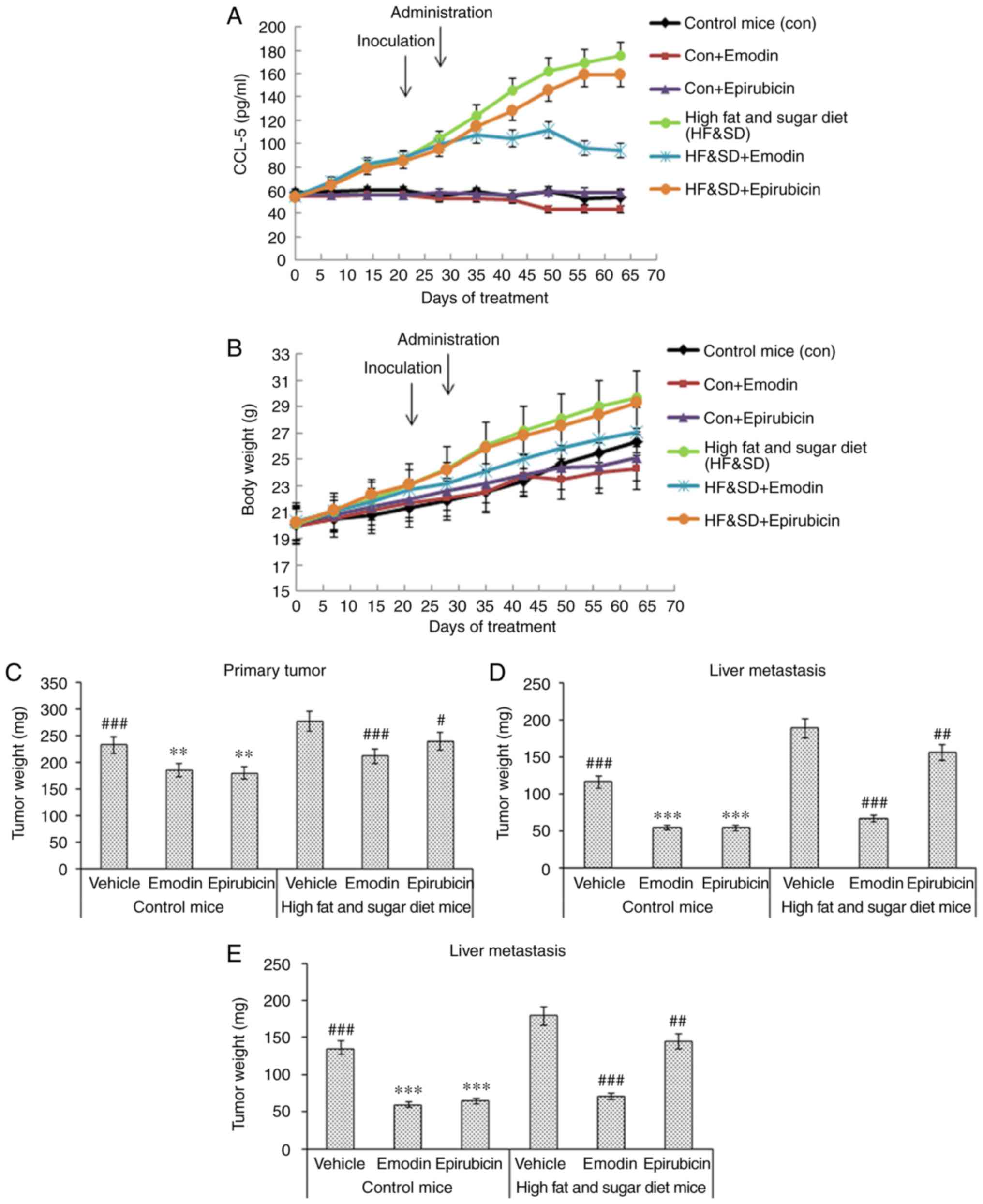Emodin inhibits epithelial‑mesenchymal transition and metastasis of triple negative breast cancer via antagonism of CC‑chemokine ligand 5 secreted from adipocytes
- Authors:
- Published online on: April 23, 2018 https://doi.org/10.3892/ijmm.2018.3638
- Pages: 579-588
Abstract
Introduction
Breast cancer is the most frequently diagnosed cancer and the leading cause of mortality among women worldwide (1,2), accounting for 23% of total cancer cases and 14% of cancer-associated mortality, according to the global cancer statistics for 2011 (3). Triple negative breast cancer (TNBC) is a subtype of breast cancer lacking the expression of estrogen receptor (ER), human epidermal growth factor receptor type 2 (HER2) and progesterone receptor (4), and accounts for ~15% of all breast cancer cases (5). Women with TNBC have relatively poor prognoses, and specific treatment guidelines are not available for these patients. In addition, due to its specific molecular expression features, TNBC is resistant to existing endocrine therapies and HER2-targeted therapies, including trastuzumab (6). Therefore, the development of possible therapeutic targeted agents for TNBC is urgently required.
Substantial effort has focused on deconstructing the molecular mechanisms underlying the development and progression of TNBC, and developing more efficient and effective therapies. A growing body of evidence indicates that adipose tissue, and more specifically adipocytes, which represent the most abundant cell type of the breast cancer microenvironment, are involved in the initiation, growth and metastasis of breast cancer (7–9). In previous studies, cancer cell growth and metastasis were found to occur predominantly in adipocyte-rich microenvironments. All adipocyte-derived factors, including adipokines, proinflammatory cytokines, chemokines, growth factors, hormones, proangiogenic factors and extracellular matrix constituents, may be considered as contributing factors for the growth, development and metastasis of breast cancer (10–12). CC-chemokine ligand 5 (CCL5), which is upregulated in breast cancer and peritumoral adipose tissue, has been demonstrated to be associated with metastasis and poorer overall survival rates in patients with TNBC (13–16). Accumulated evidence suggests that adipocytes promote the proliferation, migration and invasion of TNBC cells by inducing the expression of mesenchymal markers and promoting the epithelial-mesenchymal transition (EMT) of TNBC cells (17). E-cadherin is an epithelial-related protein, and vimentin and snail are mesenchymal-related proteins. The phosphorylation of protein kinase B (AKT) can inhibit glycogen synthase kinase-3β (GSK3β) and stabilize β-catenin, which can translocate to the nucleus and engage the transcription factors lymphoid enhancer-binding factor 1 (LEF) and T-cell factor (TCF), promoting the transcription of a series of EMT-related genes (18).
Emodin (1,3,8-trihydroxy-6-methylanthraquinone) is a biologically active anthraquinone derivative isolated from the roots and bark of Rheum palmatum, Polygonum cuspidatum medicine, and other Chinese herbs (19). Emodin has been widely investigated for its anti-atherogenic, antibacterial, anti-inflammatory, diuretic and immunosuppressive properties (20,21), in addition to its anticancer effects against a variety of cancer types, including breast (22–24), pancreatic (25,26), lung (27), liver (28), prostate (29), ovarian (30), colon (31) and gallbladder (32) cancer, among others. It has been demonstrated that emodin induces the apoptosis of human breast cancer MDA-MB-231 (33) and MDA-MB-453 (34) cells, although the potential mechanisms remain to be elucidated. In addition, the effects of emodin on the migration and invasion of TNBC cells require elucidation.
In the present study, MDA-MB-231 and MDA-MB-453 TNBC cells were co-cultured with human adipocytes and treated with emodin. The results revealed that emodin inhibited the secretion of CCL5 from adipocytes, suppressed EMT of TNBC cells, and inhibited TNBC cell proliferation and metastasis in vitro and in vivo. These observations suggest that emodin may serve as a potential therapeutic agent for TNBC.
Materials and methods
Reagents
CCL5 protein was purchased from R&D systems, Inc. (Minneapolis, MN, USA; cat. no. 278-RN-050), Rabbit anti-mouse immunoglobulin G (IgG) H&L horseradish peroxidase (HRP; cat. no. ab6728; 1:5,000), goat anti-rabbit IgG H&L HRP (cat. no. ab6721; 1:5,000), goat anti-mouse IgG H&L (Alexa Fluor® 594; cat. no. ab150116; 1:5,000) CCL5 (cat. no. ab56709; 1:1,000), phosphorylated (p-)CCR5 (cat. no. ab63411; 1:1,000), and CCR5 (cat. no. ab65850; 1:1,000) antibodies were purchased from Abcam (Cambridge, UK), p-AKT (cat. no. 4060; 1:2,000), AKT (cat. no. 9272), p-extracellular signal-regulated kinase (Erk) (cat. no. 4370; 1:1,000), Erk (cat. no. 4695; 1:1,000), matrix metalloproteinase (MMP)-2 (cat. no. 87809; 1:1,000), MMP-9 (cat. no. 13667; 1:1,000), E-cadherin (cat. no. 14472; 1:1,000) and vimentin (cat. no. 5741; 1:1,000) antibodies were purchased from Cell Signaling Technology, Inc. (Danvers, MA, USA).
Cell culture
MDA-MB-231 and MDA-MB-453 TNBC cells, purchased from the Cell Bank of the Chinese Science Institute (Shanghai, China) were cultured in 1640 medium supplemented with 10% fetal bovine serum (FBS; Gibco; Thermo Fisher Scientific, Inc., Waltham, MA, USA) and 1% penicillin-streptomycin and maintained at 37°C and 5% CO2. Human adipocytes were cultured in DMEM (Gibco; Thermo Fisher Scientific, Inc.).
Human adipose tissue
Human adipose tissue samples were obtained from mammary adipose tissue biopsies of healthy women (n=12; age 25–63 years; body mass index 24.2–29.0) undergoing surgical mammary reduction. All women were otherwise healthy and free of metabolic or endocrine diseases. Informed consent was obtained from every patient prior to the surgical procedure. The Ethics Committee of Longhua Hospital Affiliated to Shanghai University of Traditional Chinese Medicine (Shanghai, China) approved the present study. The adipose tissue was digested with collagenase, and adipose-derived stromal vascular fraction (SVF) cells were isolated and differentiated as previously reported (35). Informed consent was obtained from the patients for participation in the study.
MTT assay
An MTT assay was used to detect the effect of human adipocytes on TNBC cell viability. The supernatants of the SVF cells or adipocytes were collected, and MDA-MB-231 or MDA-MB-453 cells were incubated with the supernatant in 96-well plates at a density of 5,000 cells per well. After 24 h, epirubicin at concentrations of 0.01, 0.1, 0.5, 1 or 10 μM or emodin at concentrations of 1, 10, 50, 100 or 200 μM were added to the cell supernatant at 37°C, using three wells per concentration. After 24 h, MTT solution (10 μl) at a concentration of 5 mg/ml was added to 90 μl of culture media and incubated for 4 h at 37°C in a humidified atmosphere of 5% CO2. The supernatant was removed and 100 μl per well of DMSO was added to the plates. The optical density was measured at 492 nm in a microplate reader. The experiment was performed in triplicate.
Transwell invasion assay
The invasive capacity of the cells was evaluated with a Transwell assay in 24-well plates (Corning Life Sciences, Corning, NY, USA) according to the manufacturer’s protocol. Briefly, the upper chambers were coated with Matrigel (BD Biosciences, Franklin Lakes, NJ, USA). The MDA-MB-231 or MDA-MB-453 cells were seeded in the upper chamber of the Matrigel-coated Transwell culture system in 200 μl serum free-medium, and human SVF cells or adipocytes were seeded in the lower chamber in 500 μl medium with 10% FBS. The cells were then allowed to invade the Matrigel matrix for 24 h. Subsequently, the transmigrated cells were fixed and stained with crystal violet and counted in five randomly selected microscopic fields using an IX71 light microscope (Olympus Corporation, Tokyo, Japan). All experiments were performed in triplicate.
Wound healing assay
The MDA-MB-231 or MDA-MB-453 cells were seeded in the lower chamber of a Transwell culture system, with human SVF cells or adipocytes in the upper chamber. When cellular confluence reached ~90%, wounds were created in the confluent cells using 10-μl pipette tips. The cells were then rinsed with medium to remove any free-floating cells and debris. Wound healing was observed at 12 and 24 h within the scrape line, and representative images of the scrape lines were captured.
ELISA
The levels of interleukin-8 (IL-8), insulin-like growth factor-1 (IGF-1) and CCL5 in the supernatant of the SVF cells, adipocytes, MDA-MB-231 and MDA-MB-453 cells were detected by ELISA according to the manufacturer’s protocol (RayBiotech, Norcross, GA, USA). The TNBC cells co-cultured with human adipocytes were treated for 24 h with 0.50 μM epirubicin and 50 μM emodin (for MDA-MB-231) or with 0.25 μM epirubicin and 25 μM emodin (for MDA-MB-453). The levels of CCL5 in the supernatant of the SVF cells, adipocytes, and co-cultures were detected using ELISA.
Western blot analysis
The MDA-MB-231 cells were seeded in the lower chamber of a Transwell culture system, with human SVF cells or adipocytes in the upper chamber. When cellular confluence reached ~90%, the MDA-MB-231 cells were treated with 6 μg/ml CCL5 antibody (cat. no. 2988; Cell Signaling Technology, Inc.), 100 pg/ml CCL5 (cat. no. 96-300-06; PeproTech, Inc., Rocky Hill, NJ, USA), and 0.50 μM epirubicin or 50 μM emodin for 24 h at 37°C and 5% CO2. The protein lysates were obtained from the MDA-MB-231 cells treated with a lysis buffer (cat. no. 78501; Thermo Fisher Scientific, Inc.) with a protease inhibitor cocktail. The proteins were quantified using a BCA Kit (cat. no. 23225; Thermo Fisher Scientific, Inc.) and 10 μg protein was loaded and separated by 8–12% SDS-PAGE according to the protein weight and blotted onto a PVDF nitrocellulose membrane (Bio-Rad Laboratories, Inc., Hercules, CA, USA). The membrane was blocked in 5% milk in PBST for 1 h and then probed with primary antibodies overnight at 4°C, followed by incubation with secondary antibodies for 1 h at room temperature. The signal was then visualized with enhanced chemiluminescence reagent, following the manufacturer’s protocol (cat. no. 34080; Thermo Fisher Scientific, Inc.).
Tumor xenograft experiments
All mouse experiments were performed in accordance with approved protocols from the Shanghai Medical Experimental Animal Care Commission (Shanghai, China). A total of 72 female Balb/C nude mice (age, 4–6 weeks; weight, 18–21 g) were obtained from Shanghai BiKai Bio-Technology (Shanghai, China) and housed under specific pathogen-free conditions at constant temperature (22±2°C) and humidity (55±5%) in a 12 h light/dark schedule with ad libitum access to water and standard laboratory chow. These mice were divided into six groups. Of the mice, 36 were fed with a basic diet and 36 received a high fat and sugar diet for 20 days. All mice were inoculated subcutaneously with MDA-MB-231 cells (1×107) in 100 μl of 1640-Matrigel mixture (1:1 ratio) in the thoracic fat pad. When the tumor volumes reached an average of ~100 mm3, the mice were treated with saline orally (p.o.), three times per week, 40 mg/ml emodin p.o., once a day for 21 days, or 5 mg/ml epirubicin intravenously (i.v.) weekly for 3 weeks. The tumor volumes were measured every 5 days in two dimensions with vernier calipers. The tumor volumes were calculated using the following formula: Length × width2 × 0.5. There were 12 mice were in each group, 6 of the 12 tumor samples were immersed in 4% paraformaldehyde for hematoxylin and eosin (H&E) staining, and 6 of 12 tumor samples were separated from liver and lung tissues and weighed. Tumor tissues from the in vivo experiments were collected for immunohistochemical analysis. The experiments were approved by the Ethics Committee of Longhua Hospital Affiliated to Shanghai University of Traditional Chinese Medicine.
Cellular immunofluorescence
The cells were cultured overnight on coverslips in 6-well plates. The coverslips were then removed and maintained in 4% polyformaldehyde for 15 min, and then washed three times in PBS solution. The coverslips were then treated with 0.2% Triton X-100 for 15 min, and then blocked with 3% goat serum (Gibco; Thermo Fisher Scientific, Inc.) at room temperature for 1 h. The coverslips were then incubated with E-cadherin antibody (1:1,000) at 4°C for 2 h, and then with secondary antibody linked with Alexa Fluor 594 (1:200) for 1 h. Following staining with DAPI, the cells on the coverslips were observed under a confocal microscope.
H&E staining
Tissues were immersed in 4% paraformaldehyde for 4 h, and then transferred to 70% ethanol. Individual lobes of the tissues biopsy materials were placed in processing cassettes, dehydrated through a serial alcohol gradient, and then stained with H&E. Following staining, the sections were dehydrated through increasing concentrations of ethanol and xylene.
Statistical analysis
All statistical analyses were performed using SPSS 16.0 software (SPSS, Inc., Chicago, IL, USA). All data are presented as the mean ± standard deviation. Statistical significance was determined using a paired or unpaired Student’s t-test in cases of standardized expression data. One-way analysis of variance was performed for multiple group comparisons, and comparisons between two groups were made using the least significant difference method. P<0.05 was considered to indicate a statistically significant difference.
Results
Emodin inhibits TNBC cell proliferation and metastasis more efficiently than epirubicin under adipocyte-rich conditions
The present study investigated the effects of epirubicin and emodin on TNBCs in the supernatant of SVF cells or adipocytes. The MTT assay results suggested that the IC50 values of epirubicin and emodin against MDA-MB-231 were 0.55 and 55.2 μM respectively, and when the MDA-MB-231 cells were incubated in the supernatant of adipocytes, the IC50 values were 5.1 and 67.1 μM, respectively. Similar trends were observed with the MDA-MB-453 cells, demonstrating that, when co-cultured with adipocytes, the IC50 of epirubicin was ~9.27 times higher, compared with the value obtained without adipocytes, whereas the IC50 of emodin was only ~1.21 times higher, a finding which suggested that adipocytes led to resistance of TNBC to epirubicin, but not to emodin (Fig. 1A). The Transwell and wound healing assays demonstrated that adipocytes assisted in human TNBC MDA-MB-231 and MDA-MB-453 cell migration and invasion, and emodin caused more marked inhibition of TNBC cell migration and invasion, compared with epirubicin in the supernatant of adipocytes (Fig. 1B and C). Taken together, these findings showed that emodin inhibited TNBC cell proliferation and metastasis more efficiently than epirubicin in the supernatant of adipocytes.
Emodin inhibits the release of cytokines/chemokines and growth factors by human mammary adipocytes
It has been reported that the secretion of IL-8, CCL5 and IGF-1 by adipocytes can promote the migration of TNBC cells (16,17). In the present study, the results of the ELISA showed that the levels of IL-8, CCL5 and IGF-1 were higher in the cell supernatant of the adipocytes. The levels of these proteins were also measured in the cell culture supernatants following treatment with emodin or epirubicin. The results suggested that only CCL5 was downregulated following emodin treatment (Fig. 2A-F); however, no changes were observed following epirubicin treatment, indicating that emodin may inhibit TNBC proliferation and migration by decreasing the release of CCL5.
Emodin inhibits TNBC invasion by antagonizing the secretion of CCL5 from adipocytes
To investigate whether emodin inhibited TNBC cell invasiveness by antagonizing the secretion of CCL5 from adipocytes, TNBC cells were treated with 6 μg/ml CCL5 antibody, CCL5 100 pg/ml, and 0.5 μM epirubicin or 50 μM emodin for MDA-MB-231 cells, or 0.25 μM epirubicin or 25 μM emodin for MDA-MB-453 cells. The MTT assay results suggested that CCL5 antibody at a concentration of 6 μg/ml inhibited cell proliferation and that CCL5 reversed the inhibitory effect of emodin treatment (Fig. 3A). The Transwell assay suggested that CCL5 antibody inhibited cell invasion (Fig. 3B); however, CCL5 reversed the inhibitory effect of emodin treatment. The above results suggested that emodin may inhibit the proliferation and invasion of TNBCs by partially downregulating the secretion of CCL5.
Downstream signaling pathways of CCR5 and EMT-associated markers
To investigate the mechanism underlying the inhibitory effect of emodin on TNBC proliferation, migration and invasion via the CCL5/CCR5 pathway, the TNBC cells were treated with CCL5 antibody, emodin, or epirubicin, and the downstream signaling pathways of CCR5 and EMT-associated markers were analyzed by western blot or immunofluorescence assays. The results suggested that emodin inhibited the phosphorylation of AKT, activated GSK3β, downregulated the expression of β-catenin and mesenchymal-related proteins vimentin and snail, and upregulated the expression of epithelial-related protein E-cadherin. Epirubicin inhibited the phosphorylation of CCR5, promoted the phosphorylation of AKT, downregulated the expression of MMP-9 and snail, and upregulated the expression of GSK-β, β-catenin and E-cadherin. CCL-5 antibody downregulated the expression of CCL5, β-catenin, MMP-2, MMP-9 and snail, upregulated the expression of GSK3β and E-cadherin, and inhibited the phosphorylation of CCR5 and AKT. CCL5 promoted the phosphorylation of CCR5 and AKT, and upregulated the expression of CCL5, β-catenin, MMP-2, MMP-9 and snail. Emodin+CCL5 upregulated the expression of CCL5, activated GSK3b, MMP-2 and snail, and promoted the phosphorylation of CCR5 and AKT (Fig. 4A and B). These results indicated that emodin negatively regulated the downstream signaling pathways of CCR5 and EMT-associated markers, thereby inhibiting invasion and migration.
In vivo evaluation of the effect of emodin on TNBC tumor growth and metastasis
The in vivo assay showed that emodin inhibited the tumor growth and metastasis of TNBC cells by decreasing levels of CCL5 in the serum of mice fed a high fat and sugar diet. The nude mice were fed a high fat and sugar diet for 20 days and then inoculated with TNBC cells in the fat pad. After 7 days, the mice were treated with 40 mg/ml emodin p.o. once a day for 21 days, or 5 mg/ml epirubicin i.v. weekly for 3 weeks. The results suggested that emodin downregulated the level of CCL5, whereas epirubicin did not affect the level of CCL5 (Fig. 5A). Emodin had a similar effect on control nude mice bearing MDA-MB-231 with epirubicin; however, the efficacy of emodin was significantly higher on the nude mice fed a high fat and sugar diet than epirubicin according to the body weight (Fig. 5B), primary tumor (Fig. 5C), liver metastasis (Fig. 5D) and lung metastasis (Fig. 5E) tumor weight. The H&E staining data suggested that compared with the vehicle and epirubicin groups the emodin reduced lung (Fig. 5F) and liver metastasis (Fig. 5G) of the TNBC tumor. The above results indicated that emodin inhibited tumor growth and the lung and liver metastasis of TNBC cells by decreasing levels of CCL5 in mice fed a high fat and sugar diet (Fig. 5).
Discussion
Breast cancer is the most common malignant tumor in women worldwide. The majority of patients with advanced breast cancer have serious systemic metastasis, which results in a high mortality rate (1,2). Adipose tissue represents a major component of the tumor microenvironment, particularly for breast cancer (7,8). In addition to providing an insulating and mechanically supportive site for energy storage, adipose tissue has endocrine functions, regulating systemic energy and metabolic homeostasis through a complex network of signals (8,36). Data from previous investigations have suggested that the release of CCL5 by adipocytes contributes to increase motility and invasiveness of breast cancer cells. CCL5 is detectable in peritumoral adipose tissue of TNBCs, and correlates with lymph node and distant metastases, and reduced overall survival rates (16). The process of EMT is involved in embryogenesis, underlying mesoderm formation and neural crest development (37), and is known to be involved in wound healing, fibrosis and tumor progression by enhancing tumor cell migration and invasion (9,38). Adipocytes may contribute to EMT in breast cancer cells through the secretion of CCL5 (16).
The results of the present study suggested that emodin inhibited TNBC proliferation, migration and metastasis more effectively than epirubicin in adipocyte co-culture conditions. Therefore, the present study investigated the underling mechanisms. The ELISA results showed that emodin inhibited the release of CCL5 from human adipocytes, leading to the investigation of whether emodin inhibited TNBC proliferation, migration and invasion by downregulating the secretion of CCL5. The results of the investigations confirmed this.
In the present study, TNBC cells co-cultured with adipocytes were treated with CCL5 antibody, emodin, or epirubicin, and the downstream signaling pathways of CCR5- and EMT-associated markers were analyzed by western blot analysis and confocal microscopy. The phosphorylation of AKT can inhibit GSK3h, which may stabilize β-catenin. The latter may translocate to the nucleus and engage the transcription factors TCF and LEF1, and promote transcription of a series of EMT-related genes (18). The data in the present study suggested that emodin inhibited the phosphorylation of CCR5 and AKT, downregulated the expression of β-catenin, vimentin and snail, and upregulated the expression of E-cadherin. The above results indicated that emodin inhibited invasion and migration by suppressing the downstream signaling pathways of CCR5- and EMT-associated markers.
The in vivo data showed that a high fat and sugar diet contributed to tumor growth and metastasis. Emodin inhibited tumor growth, and inhibited the lung and liver metastasis of TNBC cells in vivo by decreasing the secretion of CCL5 in the serum of mice fed a high fat and sugar diet.
In conclusion, emodin was shown to antagonize the secretion of CCL5 from adipocytes and inhibit EMT of TNBC cells, further inhibiting tumor growth, and lung and liver metastasis. However, the mechanism underlying the negative regulation of CCL5 release by emodin requires elucidation in future investigations. The above data suggest a novel therapeutic agent for preventing TNBC metastasis.
Acknowledgments
Not applicable.
References
|
Siegel RL, Naishadham D and Jemal A: Cancer statistics, 2013. CA Cancer J Clin. 63:11–30. 2013. View Article : Google Scholar : PubMed/NCBI | |
|
Siegel RL, Miller KD and Jemal A: Cancer statistics, 2016. CA Cancer J Clin. 66:7–30. 2016. View Article : Google Scholar : PubMed/NCBI | |
|
Jemal A, Bray F, Center MM, Ferlay J, Ward E and Forman D: Global cancer statistics. CA Cancer J Clin. 61:69–90. 2011. View Article : Google Scholar : PubMed/NCBI | |
|
Brenton JD, Carey LA, Ahmed AA and Caldas C: Molecular classification and molecular forecasting of breast cancer: Ready for clinical application? J Clin Oncol. 23:7350–7360. 2005. View Article : Google Scholar : PubMed/NCBI | |
|
Cleator S, Heller W and Coombes RC: Triple-negative breast cancer: Therapeutic options. Lancet Oncol. 8:235–244. 2007. View Article : Google Scholar : PubMed/NCBI | |
|
Foulkes WD, Smith IE and Reisfilho JS: Triple-negative breast cancer. N Engl J Med. 363:1938–1948. 2010. View Article : Google Scholar : PubMed/NCBI | |
|
Calle EE and Kaaks R: Overweight, obesity and cancer: Epidemiological evidence and proposed mechanisms. Nat Rev Cancer. 4:579–591. 2004. View Article : Google Scholar : PubMed/NCBI | |
|
Nieman K, Romero IL, Van Houten B and Lengyel E: Adipose tissue and adipocytes support tumorigenesis and metastasis. Biochim Biophys Acta. 1831:1533–1541. 2013. View Article : Google Scholar : PubMed/NCBI | |
|
Bifulco M and Pisanti S: ‘Adiponcosis’: A new term to name the obesity and cancer link. J Clin Endocrinol Metab. 98:4664–4665. 2013. View Article : Google Scholar : PubMed/NCBI | |
|
Iyengar P, Combs TP, Shah SJ, Gouon-Evans V, Pollard JW, Albanese C, Flanagan L, Tenniswood MP, Guha C, Lisanti MP, et al: Adipocyte-secreted factors synergistically promote mammary tumorigenesis through induction of anti-apoptotic transcriptional programs and proto-oncogene stabilization. Oncogene. 22:6408–6423. 2003. View Article : Google Scholar : PubMed/NCBI | |
|
Park J, Morley TS, Kim M, Clegg DJ and Scherer PE: Obesity and cancer-mechanisms underlying tumour progression and recurrence. Nat Rev Endocrinol. 10:455–465. 2014. View Article : Google Scholar : PubMed/NCBI | |
|
D’Esposito V, Passaretti F, Hammarstedt A, Liguoro D, Terracciano D, Molea G, Canta L, Miele C, Smith U, Beguinot F and Formisano P: Adipocyte-released insulin-like growth factor-1 is regulated by glucose and fatty acids and controls breast cancer cell growth in vitro. Diabetologia. 55:2811–2822. 2012. View Article : Google Scholar : | |
|
Luboshits G, Shina S, Kaplan O, Engelberg S, Nass D, Lifshitz-Mercer B, Chaitchik S, Keydar I and Ben-Baruch A: Elevated expression of the CC chemokine regulated on activation, normal T cell expressed and secreted (RANTES) in advanced breast carcinoma. Cancer Res. 59:4681–4687. 1999.PubMed/NCBI | |
|
Balkwill FR: Cancer and the chemokine network. Nat Rev Cancer. 4:540–550. 2004. View Article : Google Scholar : PubMed/NCBI | |
|
Azenshtein E, Luboshits G, Shina S, Neumark E, Shahbazian D, Weil M, Wigler N, Keydar I and Ben-Baruch A: The CC chemokine RANTES in breast carcinoma progression: Regulation of expression and potential mechanisms of promalignant activity. Cancer Res. 62:1093–1102. 2002.PubMed/NCBI | |
|
D’Esposito V, Liguoro D, Ambrosio MR, Collina F, Cantile M, Spinelli R, Raciti GA, Miele C, Valentino R, Campiglia P, et al: Adipose microenvironment promotes triple negative breast cancer cell invasiveness and dissemination by producing CCL5. Oncotarget. 7:24495–24509. 2016. | |
|
Lee Y, Jung WH and Koo JS: Adipocytes can induce epithelial-mesenchymal transition in breast cancer cells. Breast Cancer Res Treat. 153:323–335. 2015. View Article : Google Scholar : PubMed/NCBI | |
|
Yang L, Lin C and Liu ZR: P68 RNA helicase mediates PDGF-induced epithelial mesenchymal transition by displacing Axin from beta-catenin. Cell. 127:139–155. 2006. View Article : Google Scholar : PubMed/NCBI | |
|
Shang X and Yuan Z: Determination of six components in Rhubarb by cyclodextrin-modified micellar electrokinetic chromatography using a mixed micellar system of sodium cholate and sodium taurocholate. Analytica Chimica Acta. 456:183–188. 2002. View Article : Google Scholar | |
|
Xia XM, Li BK, Xing SM and Ruan HL: Emodin promoted pancreatic claudin-5 and occludin expression in experimental acute pancreatitis rats. World J Gastroenterol. 18:2132–2139. 2012. View Article : Google Scholar : PubMed/NCBI | |
|
Zhou M, Xu H, Pan L, Wen J, Guo Y and Chen K: Emodin promotes atherosclerotic plaque stability in fat-fed apolipoprotein E-deficient mice. Tohoku J Exp Med. 215:61–69. 2008. View Article : Google Scholar | |
|
Guo J, Li W, Shi H, Xie X, Li LR, Tang H, Wu M, Kong Y, Yang L, Gao J, et al: Synergistic effects of curcumin with emodin against the proliferation and invasion of breast cancer cells through upregulation of miR-34a. Mol Cell Biochem. 382:103–111. 2013. View Article : Google Scholar : PubMed/NCBI | |
|
Huang Z, Chen G and Shi P: Effects of emodin on the gene expression profiling of human breast carcinoma cells. Cancer Detect Prev. 32:286–291. 2009. View Article : Google Scholar : PubMed/NCBI | |
|
Zu C, Zhang M, Xue H, Cai X, Zhao L, He A, Qin G, Yang C and Zheng X: Emodin induces apoptosis of human breast cancer cells by modulating the expression of apoptosis-related genes. Oncol Lett. 10:2919–2924. 2015. View Article : Google Scholar | |
|
Lin SZ, Wei WT, Chen H, Chen KJ, Tong HF, Wang ZH, Ni ZL, Liu HB, Guo HC and Liu DL: Antitumor activity of emodin against pancreatic cancer depends on its dual role: Promotion of apoptosis and suppression of angiogenesis. PLoS One. 7:e421462012. View Article : Google Scholar : PubMed/NCBI | |
|
Liu A, Sha L, Shen Y, Huang L, Tang X and Lin S: Experimental study on anti-metastasis effect of emodin on human pancreatic cancer. Zhongguo Zhong Yao Za Zhi. 36:3167–71. 2011.In Chinese. | |
|
He L, Bi JJ, Guo Q, Yu Y and Ye XF: Effects of emodin extracted from Chinese herbs on proliferation of non-small cell lung cancer and underlying mechanisms. Asian Pac J Cancer Prev. 13:1505–1510. 2012. View Article : Google Scholar : PubMed/NCBI | |
|
Yu JQ, Bao W and Lei JC: Emodin regulates apoptotic pathway in human liver cancer cells. Phytother Res. 27:251–257. 2013. View Article : Google Scholar | |
|
Cha TL, Qiu L, Chen CT, Wen Y and Hung MC: Emodin down-regulates androgen receptor and inhibits prostate cancer cell growth. Cancer Res. 65:2287–2295. 2005. View Article : Google Scholar : PubMed/NCBI | |
|
Xue H, Chen Y, Cai X, Zhao L, He A, Guo K and Zheng X: The combined effect of survivin-targeted shRNA and emodin on the proliferation and invasion of ovarian cancer cells. Anticancer Drugs. 24:937–944. 2013. View Article : Google Scholar : PubMed/NCBI | |
|
Ma YS, Weng SW, Lin MW, Lu CC, Chiang JH, Yang JS, Lai KC, Lin JP, Tang NY, Lin JG and Chung JG: Antitumor effects of emodin on LS1034 human colon cancer cells in vitro and in vivo: Roles of apoptotic cell death and LS1034 tumor xenografts model. Food Chem Toxicol. 50:1271–1278. 2012. View Article : Google Scholar : PubMed/NCBI | |
|
Wang W, Sun Y, Li X, Li H, Chen Y, Tian Y, Yi J and Wang J: Emodin potentiates the anticancer effect of cisplatin on gallbladder cancer cells through the generation of reactive oxygen species and the inhibition of survivin expression. Oncol Rep. 26:1143–1148. 2011.PubMed/NCBI | |
|
Sun Y, Wang X, Zhou Q, Lu Y, Zhang H, Chen Q, Zhao M and Su S: Inhibitory effect of emodin on migration, invasion and metastasis of human breast cancer MDA-MB-231 cells in vitro and in vivo. Oncol Rep. 33:338–346. 2015. View Article : Google Scholar | |
|
Yan Y, Su X, Liang Y, Zhang J, Shi C, Lu Y, Gu L and Fu L: Emodin azide methyl anthraquinone derivative triggers mitochondrial-dependent cell apoptosis involving in caspase-8-mediated Bid cleavage. Mol Cancer Ther. 7:1688–1697. 2008. View Article : Google Scholar : PubMed/NCBI | |
|
Isakson P, Hammarstedt A, Gustafson B and Smith U: Impaired preadipocyte differentiation in human abdominal obesity: Role of Wnt, tumor necrosis factor-alpha, and inflammation. Diabetes. 58:1550–1557. 2009. View Article : Google Scholar : PubMed/NCBI | |
|
Poulos SP, Hausman DB and Hausman GJ: The development and endocrine functions of adipose tissue. Mol Cell Endocrinol. 323:20–34. 2010. View Article : Google Scholar | |
|
Duband JL, Monier F, Delannet M and Newgreen D: Epithelium-mesenchyme transition during neural crest development. Acta Anat. 154:63–78. 1995. View Article : Google Scholar : PubMed/NCBI | |
|
Kalluri R and Neilson EG: Epithelial-mesenchymal transition and its implications for fibrosis. J Clin Invest. 112:1776–1784. 2003. View Article : Google Scholar : PubMed/NCBI |



